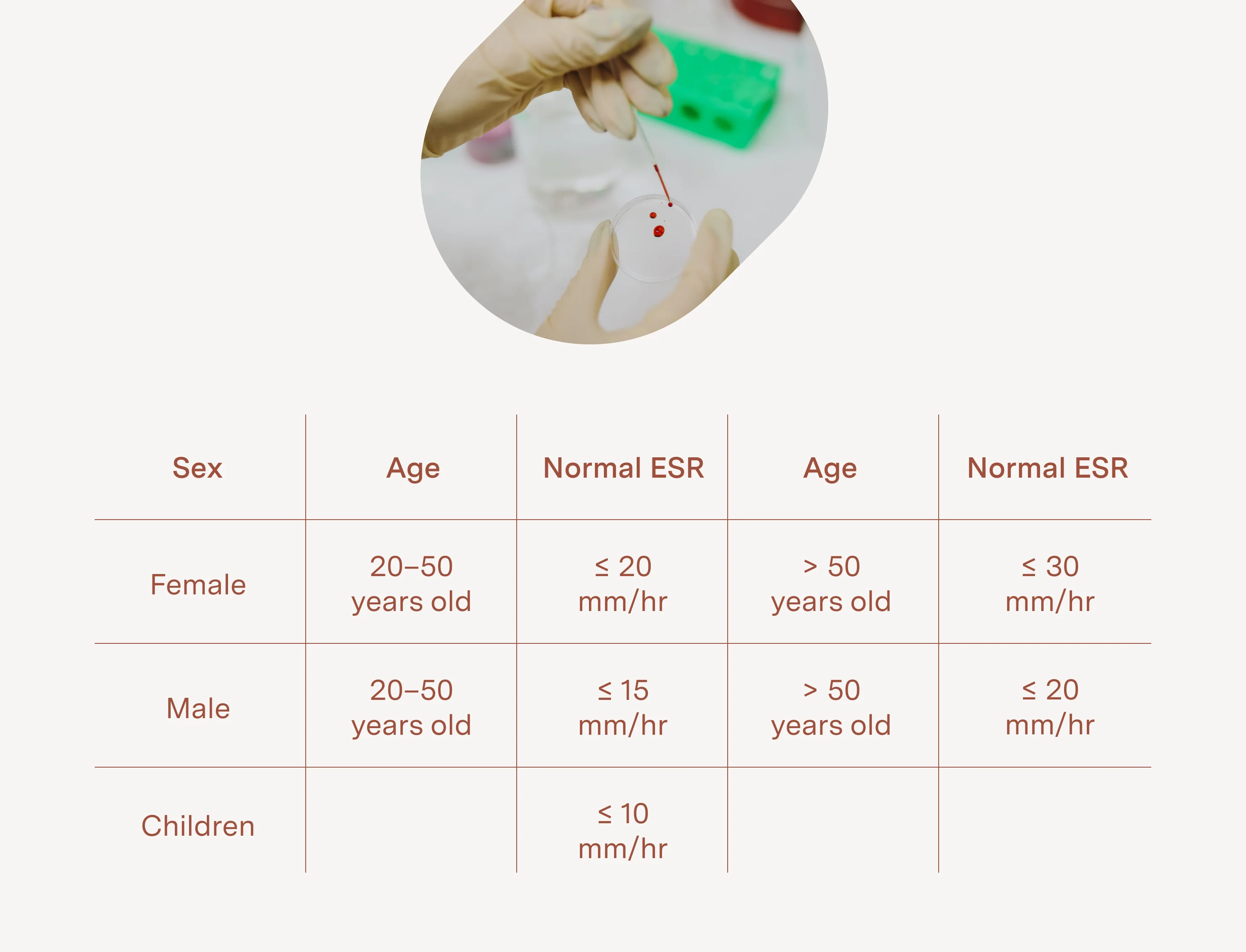The erythrocyte sedimentation rate (ESR, or sed rate) serum test has been used as a nonspecific marker of inflammation since the early 1900s. While it has been a staple lab test for rheumatoid arthritis (RA) monitoring, there are drawbacks to its use as a standalone tool. Several influences on ESR values, including sex, age, genetic differences in blood cells, and other inflammatory health conditions, mean a normal sed rate for rheumatoid arthritis is hard to define.
Whether you are an expert in decoding lab results or learning about RA for the first time, this article will clarify the meaning and use of the ESR laboratory test, and introduce additional tools for RA management. (Source, Source)

What Is Rheumatoid Arthritis?
Unlike other forms of arthritis, RA is an autoimmune inflammatory response in the joints, most commonly of the hands or knees. In RA, cells in these joints (synovial cells) overpopulate and trigger inflammation and joint destruction. While there are some similarities, there are key differences between RA and osteoarthritis, another common type of inflammatory arthritis.
Osteoarthritis, like RA, affects mobility and causes discomfort, stiffness, and pain in the affected joints. However, whereas osteoarthritis is caused by wear and tear on joints and is not autoimmune in nature, RA can have systemic, or bodywide symptoms, with inflammatory effects on the cardiovascular and nervous systems, the lungs, skin, and eyes. Other symptoms specific to RA can include fatigue, pain, weight loss, prolonged body stiffness, and swelling of joints.
Like other autoimmune diseases, the development of RA is due to a combination of genetic and environmental factors that go beyond age and overuse of a body system or part (as with osteoarthritis). (Source, Source)

Risk Factors for Rheumatoid Arthritis
Risk factors for autoimmune conditions include a combination of inherited and lifestyle factors. While some we cannot change, such as family history, there are modifiable factors that can influence the development and severity of RA.
Modifiable Risk Factors
- Body mass index (BMI) over 30 and body fat gain after initial treatment are associated with more severe RA. Higher body fat can increase inflammatory immune cells, worsen inflammation in the synovial membranes of joints, and increase RA activity.
- Nutrition, especially deficiencies of omega-3 fatty acids and vitamin D, are significantly associated with RA severity and the ability to maintain remission.
- Smoking may increase the risk of developing RA.
- Increased stress (especially work stress) is associated with difficulty maintaining RA remission.
Non-Modifiable Risk Factors
- Biologically female sex
- Family history of RA
- Hormonal fluctuations (e.g., during menopause, menstruation, and pregnancy), are associated with the risk and varying severity of RA, likely due to the immune-system-stimulating properties of sex hormones such as estrogen.
(Source, Source, Source, Source, Source, Source)

Criteria For Rheumatoid Arthritis Diagnosis
Rheumatoid arthritis diagnosis is anything but straightforward. Multiple lab tests can be used to support a diagnosis of RA indirectly, but none are direct measurements of RA. Abnormal labs that suggest an RA diagnosis may look completely different from one person to the next. When considering a diagnosis of RA, your health care provider may use a scoring systems that takes into account factors such as:
- the number and size of affected joints
- presence of RA biomarkers
- duration of symptoms
(Source)
Biomarkers for Rheumatoid Arthritis
Biomarkers are laboratory test indicators of biological processes that can be related to a health condition. Biomarkers may be abnormal for some (but not all) people with RA. Biomarkers are useful for diagnosing RA and other inflammatory conditions, as well as for monitoring disease progression and how well treatment is working. Biomarkers and lab tests for RA monitoring can include:
- rheumatoid factor: an autoimmune antibody seen in RA but also in infections and other rheumatic conditions (involving the joints, muscles, and bones)
- anti-citrullinated protein antibodies: another autoimmune antibody seen in RA and also in other rheumatic conditions
- C-reactive protein: a marker of body-wide inflammation
- erythrocyte sedimentation rate: a marker of body-wide inflammation
- inflammatory cytokines: cells that are involved in inflammatory processes, such as tumor necrosis factor and interleukin-6
- complete blood count: measurement of red and white blood cells, useful for anemia and infection screening
(Source, Source, Source, Source)
What Is an Erythrocyte Sedimentation Rate?
Sed rate is a nonspecific marker of inflammation that may be occurring anywhere in the body. It is a useful measurement because in an inflammatory response, blood levels of proteins such as fibrinogen tend to rise. Increased fibrinogen levels cause red blood cells to stick together in clumps, which makes them fall to the bottom of the test tube more quickly than they otherwise would. (Source)

What Is a Normal ESR in Rheumatoid Arthritis?
Although ESR is a standard biomarker used in RA, many different factors can affect your sed rate. If you are biologically female, your baseline ESR is expected to be 1.22 times higher than if you had been biologically male. Additionally, studies in adults have found that ESR increases with age, about 1.2 times for each decade. Normal ranges based on your age and sex are usually provided with your lab results. (Source, Source, Source)

The most common method used to measure ESR is known as the Westergren method, in which blood is placed in a 200 mm tube and the fall of erythrocytes to the bottom of the tube (sedimentation) is observed for an hour. There are newer, automated ESR methods being developed that give faster results, but how they compare to the Westergren Method remains to be seen. Following the Westergren method, here are the normal values for sed rates:
Sed Rate Criteria for RA Remission
Although ESR is a standard lab in RA monitoring and diagnosis, a majority of patients with early RA will not have an abnormal value. If you are female and have been diagnosed with RA, your health care provider may consider a sed rate over 28 mm/hr to be elevated, indicating RA disease activity. If you have active RA with an elevated sed rate, you will probably not be considered to have achieved clinical remission before your sed rate is <30 mm/hr if female, and <20 mm/hr if male. (Source, Source, Source)

.svg)
.png)





.webp)







.webp)



.png)

 (1).webp)









 (1).jpeg)

.webp)
.webp)

.webp)

 (2).webp)

%201 (1).webp)

 2 (1).webp)




.svg)
.svg)